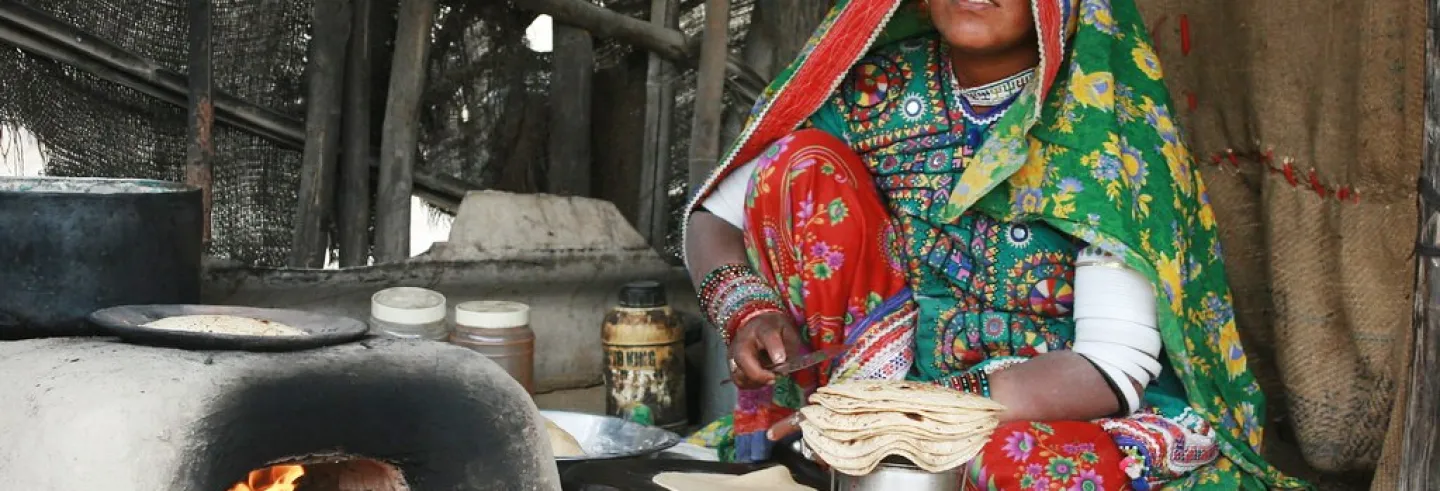By providing subsidised connections to about a third of India’s households, the Pradhan Mantri Ujjwala Yojana 1PMUY is a scheme launched by the National Democratic Alliance government in 2016 to provide subsidised LPG (liquid petroleum gas) connections to poor households. (PMUY) has ensured that almost all Indian homes have LPG connections. In the three years since its launch in 2016, 8 crore connections have been disbursed with a budget of Rs. 12,800 crores till 2020. 2The average annual budget for this national scheme is about Rs. 2500 crores. This is just 8% of Rs. 32,989 crores ear-marked as LPG fuel subsidy for the year 2019-20.
This is commendable considering that the initial target was to provide 8 crore connections by March 2020.
The scheme provides free LPG connections to poor households. The cost of the stove and the first 14.2 kg of LPG which would come to about Rs. 1500-1600, are to be borne by the consumer. This amount can be paid with the help of a loan that is available, if the consumer wants it. If the consumer opts for the loan, then the repayment instalments are adjusted against the LPG fuel subsidy due to the consumer in subsequent refills.
The PMUY has been able to increase LPG connections in households in typically under-served areas. Since 2016, Bihar, Uttar Pradesh and West Bengal have seen a remarkable increase in households with connections, with 44% of the total Ujjwala connections being disbursed in just these three states. However, in some states, the disbursals have been so high that the number of connections have become higher than the estimated number of households.
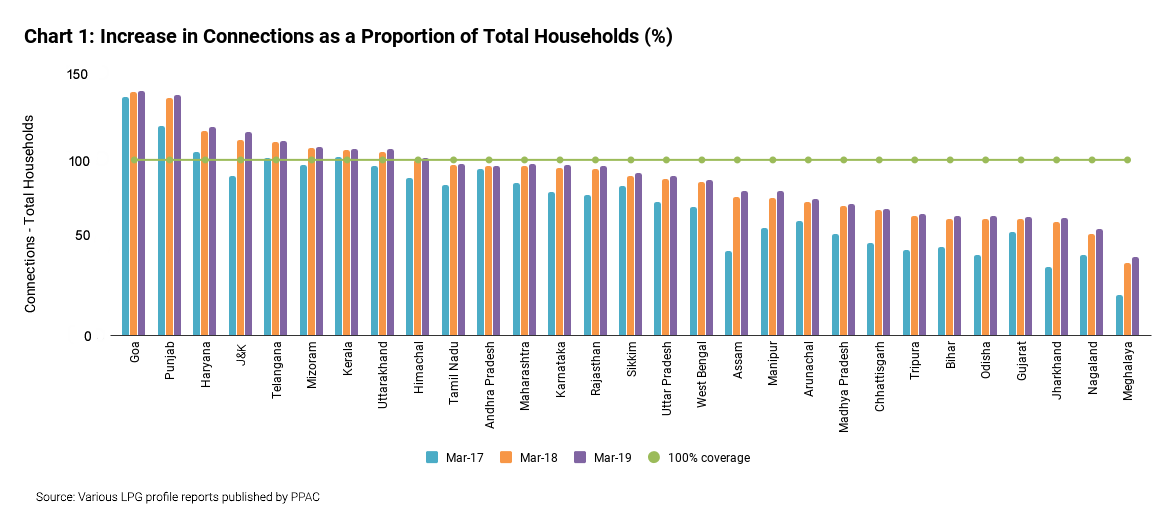
As shown in Chart 1, eight states have more connections than households as reported by the Ministry of Petroleum and Natural Gas (MoPNG). In fact, in Goa and Punjab the number of connections is 35% to 40% higher than the number of households in the state. Such discrepancies could be because there are problems with the total number of households as projected by MoPNG or because there are homes with more than one connection.
From Universal Connections to Eliminating Stacking with Solid Fuels
Keeping aside such issues with reporting, the scheme should also be evaluated based on the objectives it set out to achieve, which was to improve the health of poor rural women and their children by increasing access to clean fuels.
The emphasis on the health of rural women and children is justified as the use of solid fuels such as coal, dung cakes and firewood for cooking results in sustained exposure to indoor air pollution and increases the risk of stroke, heart disease, chronic obstructive pulmonary disease, lung cancer, and acute respiratory infections in children.
[A]bout a quarter of the PMUY consumers enrolled till the end of 2018 had not taken even a single refill, and less than half of those enrolled had purchased four or more refills.
Studies show that this exposure is responsible for 4.8 lakh premature deaths every year in India (Balakrishnan, 2019). Subsidised connections were intended to ensure households replaced these fuels with LPG. However, many households limit their use of LPG and continue to also use other fuels for cooking. Lack of sustained use of LPG or “stacking” with other fuels results in a persistence of the risks due to exposure. Hence, the intended benefits of the programme are not being achieved.
A typical Indian household would require about 9 refills per year to meet all its cooking energy needs 3An average household of 4.5 people requires about 9 refills a year for all its cooking needs, assuming a useful heat requirement of 2 MJ / capita / day (van Ruijven, 2011) and 55% efficiency of LPG stoves. . In contrast, an average PMUY consumer uses only about 3-4 refills, 38% of the normative requirement in a year. This is much lower than the 5-6 refills used by rural homes 4Data from the India Human Development Survey (IHDS), conducted in 2011-12 shows that rural households which obtained LPG connections before PMUY, stacked with solid fuels. About 55% of these rural homes with LPG connections also reported collecting fuel-wood mainly to meet cooking requirements(Desai & Vanneman, 2018). This is significant as these homes which adopted LPG even without concessional connections also continued to stack. , which itself is almost 2 refills less than the annual urban average (Lok Sabha, 2019; Lok Sabha, 2018a; Lok Sabha, 2018b) 5Of course, the rural and urban average could also be suppressed due to a large number of PMUY consumers with lower than average consumption. . This is illustrated in Chart 2.
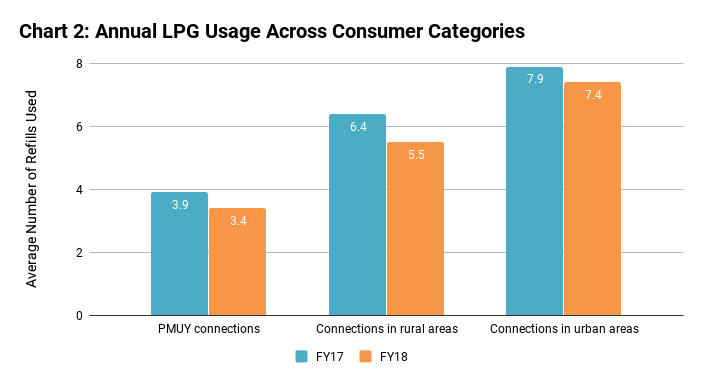
Information reported by the MoPNG indicates that there is significant stacking in PMUY kitchens. As of June 2019, about a quarter of the PMUY consumers enrolled till the end of 2018 had not taken even a single refill, and less than half of those enrolled had purchased four or more refills (MoPNG, 2019b).
Clearly, to realise the intended health benefits, there are many barriers to sustained use of LPG that need to be addressed once the connection is given. The barriers are broadly categorised as:
-- Affordability of LPG ,
-- Absence of robust distribution networks and infrastructure to ensure reliable, last mile access to LPG,
-- Behavioural aspects which need to be addressed to ensure sustained use.
Sustained LPG use could be hindered due to the taste preference for food cooked on traditional chulhas, the gendered division of responsibilities, the low value assigned to the time and labour of women and girls in the family...
Of these, the barriers or challenges related to behavioural change are complex and less understood. Sustained LPG use could be hindered due to the taste preference for food cooked on traditional chulhas, the gendered division of responsibilities, the low value assigned to the time and labour of women and girls in the family, the prevailing intra-household decision-making practices which discount the preferences of the cook within the household 6IHDS 2011-12 data shows that in 82% of households, it is the male members that take the decision regarding expensive purchases while it is the women who do most of the cooking(Desai & Vanneman, 2018). , and the current cooking habits and household time-use. Other residential energy requirements (preparation of cattle feed, water heating etc.) currently met by solid fuels may incentivise stacking. Additionally, community factors, especially around joint collection of fuel and water, could also contribute to low LPG uptake in parts of the country.
A lot more research is needed to understand the many kinds of behavioural and socio-cultural barriers that prevent LPG use. Understanding these factors would also help in addressing barriers related to affordability and reliable supply of LPG. Strategies to address these barriers need to be context specific to be effective. In order to deepen our understanding of behavioural challenges as well as the effectiveness of various strategies to address them, there is a need for many, varied, large pilots 7One such example is the engagement of 10,000 women as ambassadors in villages for the Ujjwala programme in Odisha. This initiative is also being replicated in Jharkhand. in the coming years. This is a challenge for the research and policy community.
Since increased usage of LPG and other clean-burning fuels is a preventive health initiative as much as an energy-access initiative, support can also be provided to the Ministry of Health and Family Welfare to implement pilot behavioural change initiatives that would leverage their presence on the ground under various programmes .
Here we elaborate on the affordability and reliable access barriers and provide some suggestions that can be implemented within the current institutional framework. These suggestions are provided in the spirit of initiating a discourse, which can help refine the ideas to a level where they can be effectively piloted.
Affordability of LPG
As shown in Chart 3, the unsubsidised price of LPG is on an average quite high. The average price in 2018-19 is comparable to the cost of meeting the monthly electricity demand of a typical home in India 8Based on a study of the audited accounts of electricity distribution companies in 10 states by the authors, the average cost of supplying one unit of power in 2017-18 was about Rs. 7.15.On an average, the unsubsidised LPG price in the same year was about Rs. 750 per cylinder. This amount is enough to provide electricity service to power 3 lights, 2 fans, a television and a refrigerator in a home at cost without any price support. .
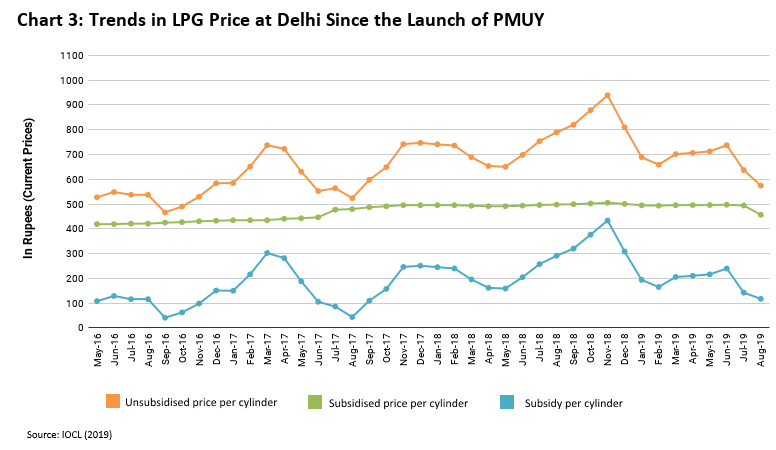
With movements in international oil prices, the price of unsubsidised LPG has risen at an average rate of 11% per annum since the launch of PMUY. For most consumers, 30% of the price is subsidised for the first 12 refills in a year. The subsidised price has remained nearly constant over the years and provided significant price stability. Even so, for many households this would still mean payment of about Rs. 375 per month to meet all their cooking requirements. In several parts of the country, alternative fuel options would be considered more affordable, especially where there is no shortage of solid fuels.
[A]n increased but graded subsidy targeted only at poor consumers will encourage beneficiaries to adopt LPG on a sustained basis.
Further, where solid fuels need to be purchased, the payments are made on a daily or weekly basis, which eases the liquidity requirement and reduces the financial strain on poor households, as compared to the lump sum payments that need to be made for LPG . In addition, PMUY connections are provided only with one cylinder unlike many domestic connections that come with two cylinders. Having two cylinders helps consumers tide over delays in replacement of empty cylinders and is necessary to eliminate stacking especially in rural areas. To address this, PMUY consumers could be provided with double bottle connections where the second bottle can even be a smaller 5 kg cylinder.
Along with double bottle connections, an increased but graded subsidy targeted only at poor consumers will encourage beneficiaries to adopt LPG on a sustained basis. A similar scheme is being implemented in Maharashtra by the Forest Department in buffer areas of 31 national parks and sanctuaries and six tiger reserves to incentivise forest dwellers to shift to LPG since 2013 9The scheme is currently known as the Dr. Shyama Prasad Mukherjee Jan-Van Vikas Yojana with an annual expenditure of Rs. 88 crores in FY18. (GoM, 2017). Under the scheme, two LPG cylinders are provided along with the connection (75% of the cost of which is subsidised by the state government) while the first six refills for the first two years are also provided with 75% of the price being subsidised by the state government. Consumers can avail the subsequent six refills at the subsidised rates notified by the MoPNG.
The MoPNG could introduce a similar scheme that provides increased but graded subsidy for poor consumers. The subsidy can begin at high levels (say, 50%- 60% of the unsubsidised price) to encourage LPG adoption and can taper off to the current subsidised price over additional refills. It is expected that this will provide enough incentive to households to begin using LPG. Once the beneficiaries see its benefits, they are likely to continue using it even at higher prices after a few years.
Even with near universal provision of subsidy, it is an unfortunate irony that most PMUY beneficiaries do not have access to subsidised LPG once they obtain the connection.
Our estimates show that the additional subsidy impact of such a scheme would be less than Rs. 75 / month / household. For 10 crore households, the additional subsidy requirement would be about Rs.8,750 crore per year on average 10The additional subsidy amount for 10 crore households in this example is just 8% of the revenue foregone by the government in the year 2018-19, which was about Rs. 1,08,000 crore (MoF, 2019). . This would imply a 20% increase in LPG fuel subsidy from prevailing levels but this increase can be minimised by measures to limit and target the subsidies.
Even with near universal provision of subsidy, it is an unfortunate irony that most PMUY beneficiaries do not have access to subsidised LPG once they obtain the connection. This is because nearly 75% of PMUY connections were availed under its “loan scheme”. As discussed earlier, beneficiaries can opt for an interest free loan of about Rs. 1500-1600 per connection which is recovered against the LPG fuel subsidy due to the consumer in subsequent refills.
Therefore, PMUY beneficiaries cannot access subsidised LPG until they have purchased about 7-8 refills at unsubsidised prices in order to repay the loan they may have taken. This limits uptake of LPG among many PMUY beneficiaries who could be prolonging the use of the first cylinder through stacking or completely switching to alternate fuels.
To address this, the loan scheme should be withdrawn from the PMUY scheme and the subsidy for each connection increased to account for the cost of the stove. Pending dues under the existing loan scheme should be written off to encourage LPG consumption. The write-offs for the existing loans and the increased subsidy outlay to be given out would together involve a one-time cost of only about Rs. 8,500 crore. Such a move would go a long way towards encouraging refill purchases by PMUY consumers.
Managing the Financial Impact of Increased Price Support
Many of the suggestions to address affordability require increased financial support from the Government of India. These costs should be viewed as a social investment, given the multiple health, gender and economic benefits to be gained (Prayas, 2018; Smith & Sagar, 2014). Nonetheless, it would be good to minimise and manage these costs, and the suggestions provided here are in that spirit.
Currently, about 96% of LPG consumers, i.e. 25 crore households are subsidised 11As per the Ministry of Petroleum and Natural Gas website, 25.53 crore households have availed subsidy under DBTL in 2019. . Therefore, there is significant room to reduce the pool of those receiving LPG subsidy even beyond campaigns such as “Give it up” which nudge consumers to voluntarily opt out from receiving the subsidy. The existing scheme of excluding consumers with a taxable income of more than Rs. 10 lakh per annum (MoF, 2019) will have limited impact given the small number of taxpayers in that bracket. (In the year 2017-18 only 45 lakh consumers reported a taxable income which was more than Rs. 10 lakh per annum.)
A straightforward but politically bold step to improve targeting would be to shift to an “opt-in” system for the subsidy from the current “opt-out”. LPG consumers can be automatically excluded from the subsidy net based on well-defined wealth indicators. Households that are automatically excluded but are deserving of subsidy can submit additional documentation and provide necessary proof to claim these subsidies. Introduction of this scheme should be preceded by an extensive information campaign to avoid inconvenience to those who genuinely deserve subsidy.
If the average efficiency of stoves in use improves to even the lowest rated level, it would lead to an about 19% annual saving in LPG consumption and therefore a corresponding reduction in subsidy requirement.
LPG stoves in India are only subject to voluntary efficiency standards, the least efficient of which specifies a thermal efficiency of 68% (BEE, 2019). This is reportedly about 13 percentage points better than the stoves available in the market. MoPNG, supported by the Petroleum Conservation Research Association, can make the efficiency standards for LPG stoves mandatory, and promote rapid market transformation through schemes such as bulk procurement and replacement programmes for efficient stoves as was successfully done with bulb replacement with LED bulbs under the UJALA scheme 12The Unnat Jyoti by Affordable LEDs and Appliances for All (UJALA) launched in 2015 has been instrumental in bulk procurement and disbursal of low cost energy efficient appliances particularly LED bulbs. . If the average efficiency of stoves in use improves to even the lowest rated level, it would lead to an about 19% annual saving in LPG consumption and therefore a corresponding reduction in subsidy requirement.
Since an average Indian household requires only about 9 refills per year to meet its cooking energy requirements, the subsidy can be limited to 9 or 10 refillsper year. With measures to increase stove efficiency, over time the subsidised refills can even be reduced to 8 every year. Even a 5% overall subsidy reduction by this measure can help provide increased subsidy support to 67 lakh poor households. Concerted efforts to encourage adoption of other modern fuels such as electricity and piped natural gas in urban areas can also help reduce LPG subsidies.
In addition to limiting the outlay on the subsidy, state governments can be made partners to provide LPG price support for the poor. There are precedents to this in states such as Chhattisgarh, Jharkhand 13Jharkhand Government recently launched a scheme to provide the second refill free of cost to Ujjwala beneficiaries. , Maharashtra, Punjab and Rajasthan (Shailendra Kumar Sharma, 2017; GoR, 2018; GoM, 2017).
The government levies various cesses such as the education cess, health cess, cess on crude oil, road and infrastructure cess and GST compensation cess, which are together expected to yield more than Rs. 3,20,000 crore in 2019-20 (MoF, 2019). The additional annual requirement for graded LPG subsidy is equivalent to just 3% of this expected revenue and the government could consider financing the additional subsidy requirement from similar revenue sources.
Addressing Barriers to Reliable Access to LPG
Even if the affordability barrier is addressed, LPG use will not increase if there is no reliability in the supply of refills to poor households. The current arrangements to deliver LPG, especially the infrastructure for bulk transportation, bottling and distribution in rural areas need to be evaluated based on whether it is adequate, financially viable and operationally sustainable.
As there is limited information and research available in the public domain in this regard, it is challenging to provide a comprehensive overview of the issues that need to be addressed. Even so, there are some indications that there is a need for sustained investment in the supply chain, especially with respect to bottling and distribution to ensure reliable LPG access.
As of April 2019, India had 192 LPG bottling plants located across the country with a capacity of 18.34 million metric tonnes per annum (PPAC, 2019). Since the launch of PMUY, this capacity has increased at an average rate of 9% every year. However, active domestic connections alone have increased by 21% every year in this period. It is not clear if the current bottling capacity would be enough to cater to all LPG consumers, especially if poor consumers increase their consumption.
If we assume that all active domestic connections in 2019, which include PMUY consumers, use at least 6 refills in a year, the bottling capacity required would be 36% more than the current capacity 14Assuming that commercial demand for LPG remains the same as the current year. . The bottling capacity is reported based on the number of eight hour shifts presently in operation in plants. Despite safety guidelines, some plants are even operating 24x7 with three shifts for some periods to cater to demand. Therefore, there is limited scope to augment existing capacity by increasing the number of shifts. So there is an urgent need to plan to enhance India’s bottling capacity in the coming years to meet demand.
Since the launch of PMUY, 5,821 distributors have been added, 62% of which were added in the last year. However, this rapid growth in distributors is not enough to keep pace with the increase in consumers. In 2016, each distributor was handling an average of 9,328 domestic consumers and, in 2019, this average statistic has shot up by 20% to 11,181 consumers. To maintain an average of around 9,000 consumers in 2019, an additional 5,700 distributors would be required. Recognizing this, the Oil Marketing Companies (OMCs) implementing the programme, had decided to appoint 10,000 new LPG distributors in 2017 to cater to the rise in demand. However, the response to their call for applications was lukewarm probably due to the existing business model which makes it challenging to run a financially viable operation in particularly in a rural area.
LPG distributors receive a commission on a per refill basis from the OMCs, which is expected to cover all their expenses and provide some returns. The commission, specified by the MoPNG, consists of an establishment charge (to manage costs and day to day operations), and a delivery charge to cover the cost of last-mile delivery to the consumer premises (MoPNG, 2019). Chart 4 shows the revisions in the commission since the launch of PMUY. It stands at about Rs 51 per refill in the first half of 2019 and is expected to increase to Rs 62 by October 2019 (MoPNG, 2019).
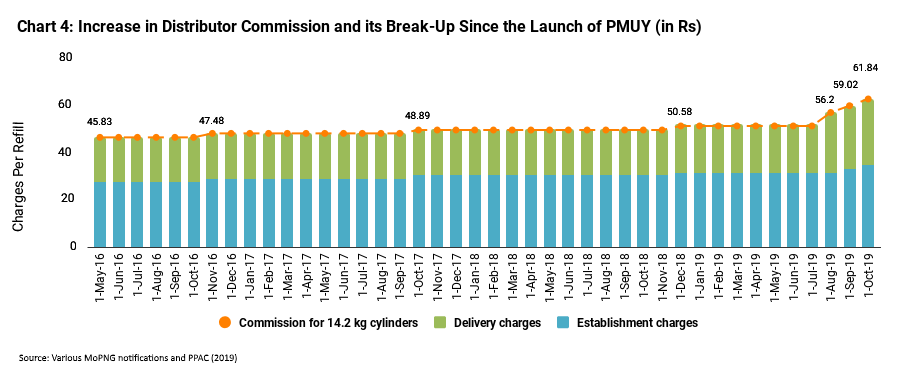
While the proposed increase in commission may address some challenges faced by distributors in general, it is unlikely to address the challenges of rural distributors in particular, whose clientele is poorer (reducing revenues) and dispersed over a wider area (increasing costs). Without appropriate incentives, appointing new distributors will continue to be a challenge. Further, lack of adequate returns for existing distributors is likely to result in poor consumer service and perhaps a temptation to indulge in practices such as LPG diversion. This could be detrimental to increasing LPG use among rural poor and should be addressed expeditiously.
To improve the viability of distributors in rural areas, an incentive-based commission can be provided. This commission could be a percentage of the total unsubsidised LPG price over and above the flat per-refill commission currently being provided, and could include two components. One component could be based on refill sales to PMUY and poor consumers beyond a certain threshold level (say, 5,000 per quarter). The second component could be directly related to the consumer service performance of the distributor. Such incentives can increase the viability of cash-strapped distributors and should spur greater innovation in business and service models. For example, they can consider servicing consumers through intermediaries such as PDS outlets or common service centres which can stock up to 100 kg of LPG and can act as sub-retailers in return for a small fee.
Currently, LPG distributors are bound by the LPG marketing discipline guidelines (OMCs in India, 2018). However, this may not be sufficient to ensure quality service to rural consumers. To address this, it is suggested that the MoPNG should publish a revised and comprehensive standards of performance document for OMCs and distributors, which goes beyond the LPG marketing guidelines. For example, it should stipulate the expected time to provide various services, and the escalation pathways and penalties applicable in case of non-compliance. Distributor and OMC compliance to these performance standards should be tracked periodically and made publicly available.
Besides the viability of the distributors, there could be several other issues being faced by rural consumers which are not being captured or addressed in a systematic manner. Many of them may be systemic issues rather than individual consumer-specific grievances. In order to capture such implementation issues in rural areas, it is important that the OMCs and distributors organise public meetings to promote awareness about consumer rights and discuss LPG service related issues on, say, a bi-annual basis. Such meetings should be structured so that consumers can freely air their problems.
Conclusions
Many of the ideas discussed here can be implemented on a pilot basis to understand impacts and implementation issues before large-scale roll out. It should be noted that these ideas may not be sufficient to address all the problems. More research is required to understand aspects such as supply-chain infrastructure, distributor business models and how to facilitate behavioural change. It is hoped that in the coming years, the central government is able to back its commitment to safeguarding the health of women and children by tackling the challenges listed here and takes efforts to reduce fuel stacking and indoor air pollution.
Many of the ideas and analysis in this article have also been discussed by the authors in a policy paper titled ‘Beyond Ujjwala: Ideas to enhance LPG use sustainably’, published by the Collaborative Clean Air Policy Centre in August 2019. The authors are thankful to Narendra Pai for his research assistance and analysis inputs.

